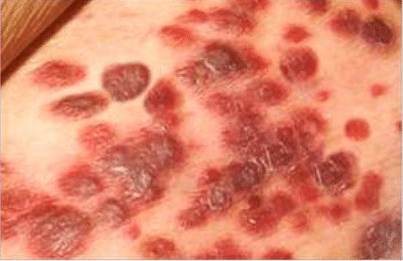A 50-year-old HIV patient presented with a painless lesion, as shown in the image.

What is the most likely diagnosis?

What is the most likely diagnosis?
Basal cell carcinoma
Kaposi sarcoma
Malignant melanoma
Squamous cell carcinoma
The Correct Option is B
Solution and Explanation
The question describes a 50-year-old HIV patient with a painless lesion. In patients with HIV/AIDS, certain conditions become more prevalent due to immunosuppression. One key diagnosis to consider in such patients, especially with lesions that appear on the skin, is Kaposi sarcoma.
Kaposi sarcoma (KS) is a tumor caused by human herpesvirus 8 (HHV-8), also known as Kaposi's sarcoma-associated herpesvirus (KSHV). It commonly presents as purple, red, or brown patches or nodules on the skin, and is typically painless. It is more prevalent in immunocompromised individuals, such as those with HIV/AIDS.
| Condition | Characteristic Features |
|---|---|
| Basal cell carcinoma | Slow-growing, often on sun-exposed skin, presents as pearly nodules |
| Kaposi sarcoma | Painless, purple lesions commonly on skin; associated with HIV |
| Malignant melanoma | Pigmented lesions with changing appearance, asymmetrical with irregular borders |
| Squamous cell carcinoma | Lesions often scaly or crusty, may ulcerate, occur on sun-exposed areas |
Given the patient's HIV status and the characteristic of the lesion, the most likely diagnosis is Kaposi sarcoma.
Top Questions on Oncology
- Which gene is most commonly mutated in Lynch syndrome (hereditary non-polyposis colorectal cancer)?
- Which of the following genes is most commonly mutated in Lynch syndrome (hereditary non-polyposis colorectal cancer)?
- Which of the following is the most common genetic mutation associated with hereditary non-polyposis colorectal cancer (HNPCC)?
- Indication and impact on survival of risk reduction surgery in female cancer patients.
- Outline management options in small cell lung carcinoma.
Questions Asked in NEET PG exam
The normal pH of arterial blood is:
- NEET (PG) - 2025
- General Science
Which enzyme is deficient in Gaucher’s disease?
- NEET (PG) - 2025
- General Science
Which of the following cranial nerves is responsible for the motor innervation of the muscles of mastication?
- NEET (PG) - 2025
- General Science
The anticoagulant effect of heparin is monitored using:
- NEET (PG) - 2025
- General Science
The causative agent of malaria is:
- NEET (PG) - 2025
- General Science